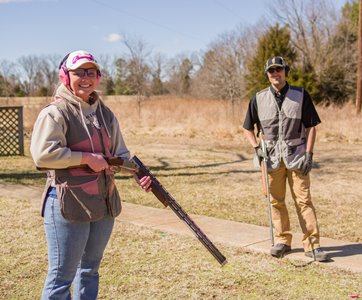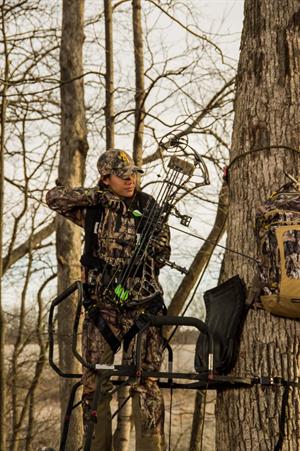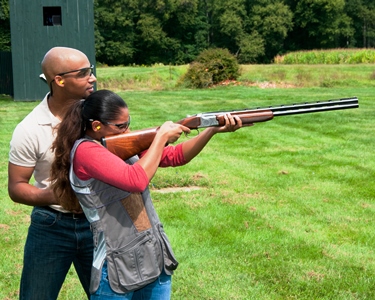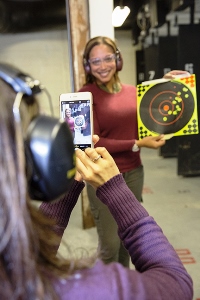Hunters and target shooters are a community of passionate, dedicated individuals who spend hours pursuing their favorite pastimes. Many of them are also committed conservationists, following in their parents’ or grandparents’ footsteps to ensure the natural world – where many of us spend our best times – is healthy and protected. We value our outdoor traditions and the nearly limitless opportunities we have to pursue them on public lands and other places across the country, including at many Izaak Walton League chapters.
For hunters and recreational shooters, these pursuits are not just hobbies but integral parts of who we are. The same can undoubtedly be said for all who cherish time spent outdoors, regardless of the paths we take to enjoy our outdoor experiences.
Unfortunately, many of us can’t pursue our outdoor passions as often as we would like. It could be a family emergency, illness, new job, or something else that demanded priority in your schedule and kept you indoors. If so, you are not alone. The numbers of active hunters and (until recently) target shooters have declined relentlessly over the past three decades. The hunting community alone has shrunk to less than 6 percent of the U.S. population. It is symptomatic of a society that continues to flock toward the "great indoors."
Should we be concerned? It depends on your point of view. Hunting and recreational shooting hold an important place in the cultural history of America. But cultures and traditions change. The question is: what else would change if these traditions faded from the fabric of America?
Benefits of Outdoor Sports
 Hunting and shooting sports are economic engines that drive communities across America. The United States is home to approximately 13.7 million hunters and more than 40 million shooting sports participants. Their combined activities support more than 1.5 million jobs each year and produce nearly $110 billion in annual economic output. Clearly a decline in these sports has serious economic consequences.
Hunting and shooting sports are economic engines that drive communities across America. The United States is home to approximately 13.7 million hunters and more than 40 million shooting sports participants. Their combined activities support more than 1.5 million jobs each year and produce nearly $110 billion in annual economic output. Clearly a decline in these sports has serious economic consequences.
One of the most pressing concerns related to a decline in hunting and shooting sports is the impact on conservation funding. An excise tax on sporting arms and ammunition has generated more than $10.5 billion for wildlife conservation since 1937. These funds are divided among state wildlife agencies for conservation, hunter education, and shooting projects and programs. In fact, approximately 70 percent of each state fish and wildlife management agency’s operating budget is funded through this excise tax and license sales. Hunters spend close to $800 million each year on licenses and permits. In addition, they donate an estimated $440 million to sportsmen’s groups and conservation organizations. Without these funds, wildlife conservation would significantly decrease – not just game animals but all wildlife species.
Hunting is also an important component of modern wildlife management. The Michigan Department of Natural Resources reports that hunting helps maintain wildlife populations "at levels compatible with human activity, land use, and available habitat." White-tailed deer are just one example: Over-abundant deer in many areas of the country pose risks to humans (Lyme disease, car collisions) as well as other wildlife species (due to over-browsed habitat). Hunting is critical to managing deer populations because humans have eliminated deer predators (wolves, cougars).
The Wildlife Society agrees, stating that "hunting, when properly regulated following biological principles, is an appropriate means of managing wildlife populations." Whether used to manage chronic wasting disease or to monitor wildlife populations through the Harvest Information Program, hunting has become an irreplaceable tool in the conservation of our nation’s abundant wildlife.
It’s not just traditions, family adventures, and community ties that will fade if outdoor recreation continues to decline – wild things and accessible public lands may vanish as well. That’s why it is critical to reverse the declines of the past three decades.
Roadmap to Recruitment
 In 2016, leaders from firearms, archery, and ammunition companies, state fish and wildlife agencies, and conservation groups (including the Izaak Walton League) developed a plan to help reverse declines in hunting and shooting sports participation. Conservation partners identified a range of issues that threaten the future of hunting and recreational shooting and prioritized strategies that organizations and individuals can initiate to turn the tide. The Wildlife Management Institute and the Council to Advance Hunting and the Shooting Sports coordinated development of the plan, which is called the "National Hunting and Shooting Sports Action Plan" (or the "National Plan").
In 2016, leaders from firearms, archery, and ammunition companies, state fish and wildlife agencies, and conservation groups (including the Izaak Walton League) developed a plan to help reverse declines in hunting and shooting sports participation. Conservation partners identified a range of issues that threaten the future of hunting and recreational shooting and prioritized strategies that organizations and individuals can initiate to turn the tide. The Wildlife Management Institute and the Council to Advance Hunting and the Shooting Sports coordinated development of the plan, which is called the "National Hunting and Shooting Sports Action Plan" (or the "National Plan").
The process through which we will implement the National Plan – and the science behind successful programs to recruit new outdoor recreationists – is commonly referred to as "R3." R3 stands for recruitment, retention, and reactivation. It ultimately describes the journey a person goes through when adopting a new activity such as hunting or target shooting.
Think of an activity you once pursued. Did the idea come to you in an isolated flash of inspiration? Did a friend show you an awesome YouTube video? Did you read a book or watch a movie that made you want to be more like the main character? Or did someone you trust simply invite you to try?
We tend to do things that look and sound like "us," particularly when others like us encourage us to try. And who exactly is "us?" It’s the people we identify with – the people with whom we share our experiences, stories, successes, and failures.
In the purest sense, R3 and the strategies of the National Plan are really all about expanding the "us." That is also R3’s biggest challenge. As any parent knows, getting kids to take part in family activities is hard enough, let alone trying to get someone else’s kids involved. So how do you recruit hunters and target shooters from among people whose social groups lack a tradition of participating in those activities?
People need much more than a first try. They need motivation, help, encouragement, and new skills. How well did your first bird house or clay pot come out? How many times did you want to quit piano? And how critical was it that you had someone in your life who said, "I’m proud of you," "Keep trying," "I’ll show you," or "Let’s do it together"?
This is the principle challenge of R3. Namely, how can an organization – or better yet, a community – become a surrogate for a natural, socially supportive learning process? Is it even possible?
Organizations vested in hunting and shooting sports have been grappling with this challenge for many years, struggling to understand why we don’t seem to be making progress. But there’s some good news: we now have a national plan that identifies areas of focus for us to begin addressing these challenges.
We will need to change our thinking and begin doing things that are outside our comfort zones. It will take time, hard work, and strong partnerships. But together, as conservation-minded sportsmen and women, we can adapt and ensure our traditions remain strong for many generations to come.
The League Can Lead
 The National Plan is just the start – it won’t make a difference unless sportsmen and women are engaged in the effort to increase our ranks. That’s why organizations such as the Izaak Walton League are working to tackle this issue head-on. "The League can lead," said IWLA Executive Director Scott Kovarovics at the League’s 2016 annual convention, where he shared opportunities for the League to contribute to this effort.
The National Plan is just the start – it won’t make a difference unless sportsmen and women are engaged in the effort to increase our ranks. That’s why organizations such as the Izaak Walton League are working to tackle this issue head-on. "The League can lead," said IWLA Executive Director Scott Kovarovics at the League’s 2016 annual convention, where he shared opportunities for the League to contribute to this effort.
There is a reason the Izaak Walton League has 230 chapters and more than 42,000 members: people need "community." The League represents a national community of like-minded individuals from all walks of life who have found enough compelling similarities in values, motivations, and joys to form a powerfully cohesive "us." That kind of community is exactly how we can make a bridge between "I’ve never really considered hunting or target shooting" to "Yeah, I think I’d like to try that."
How can the League lead?
Local Recruitment: League chapters can implement effective R3 programs on the ground. Many chapters host regularly scheduled outdoor recreation events – including shooting sports competitions, hunter education classes, and archery clinics – and provide locations where outdoor activities can be learned and practiced. Some chapters are already providing mentor programs for youth and adults interested in hunting and target shooting. The locations of many League chapters are ideal for fostering the interest of non-traditional hunting and shooting sports participants who live in suburban or urban communities. New research shows that urban areas are home to new audiences who are interested in learning to hunt or target shoot but don’t know where to begin.
The League has most of the ingredients needed to engage new hunters and target shooters:
- A community of like-minded individuals who can provide social support.
- Places to go to learn the basic knowledge and skills needed to try hunting or target shooting.
- Members who can serve as mentors, coaches, and guides to ensure new participants always have someone to help them take the next step.
- A mission and membership that can welcome new audiences who have different motivations than traditional hunters and target shooters.
- A national footprint that can create partnerships with local, state-wide, and regional R3 efforts.
State-Level Partnerships: State-level R3 partnerships offer perhaps the greatest opportunity for League engagement. Each state fish and wildlife agency is identifying how to address R3 in their states. Many state agencies are also working together through regional associations to combine efforts and increase impact. But they are not just looking to other state agencies for partnerships.
"It is critical for all partners – including Izaak Walton League chapters – to have a seat at the table and bring their ideas on how R3 can be improved locally through partnerships," said John Frampton, CEO of the Council to Advance Hunting and the Shooting Sports. In 2017, state agencies will host strategic planning meetings to learn about and discuss R3. Opportunities like these provide perfect venues for League chapters to get engaged. For example, the Iowa Department of Natural Resources hosted such a workshop this past November. Rick Cerwick, past president of the League’s Des Moines Chapter and avid hunter educator, attended the workshop and offered great input on Iowa’s R3 efforts.
Aiming for Success
 What might success look like for R3 efforts in the future? It’s another hunter heading for the woods on opening day. Another person learning to shoot for the first time at a local range. Success will come when we, as a conservation community, develop and implement effective R3 programs.
What might success look like for R3 efforts in the future? It’s another hunter heading for the woods on opening day. Another person learning to shoot for the first time at a local range. Success will come when we, as a conservation community, develop and implement effective R3 programs.
This is not something state agencies and conservation groups can do alone. It will take our whole community working together to resolve the situation we face.
Individuals can also play an important role in this effort. You can start by teaching someone you know to hunt or target shoot. Perhaps you have already taught your children or grandchildren to hunt. That is a great first step, but it’s not the only step that’s needed. The real challenge is teaching someone who is not a family member or close friend – someone who may be a little different from you and does not have anyone else to learn from. New folks with new traditions and new perspectives on hunting and target shooting.
So go find a young couple, a college student, a single mom and her kids. Help them learn the things that you love, and let them find their path to their own passions. As you teach them new skills and inspire them to keep trying, you will learn from them and with them too. The process can be challenging at times, but stick with them and you might just begin to see hunting or target shooting in a whole new light.
If we can each bring the passion of the outdoors to just one new person who never felt welcome, success will come. The cumulative "us" in the conservation community will expand exponentially, and the future of the outdoors and our place in it becomes a little more secure.
To learn more on how you can contribute to the R3 conversation, please visit www.nationalr3plan.com.